
Showdown on West Coast Docks: The Battle of Longview
(November 2011).
click on photo for article

Chicago Plant Occupation Electrifies Labor
(December 2008).
click on photo for article

May Day Strike Against the War Shuts Down
U.S. West Coast Ports
(May 2008)
click on photo for article

August 2023
SAG-AFTRA
+ WGA + IATSE + Teamsters = Power
Hollywood Strike:
Stay Out Together to Win
No One Goes Back Until Everyone Goes Back!
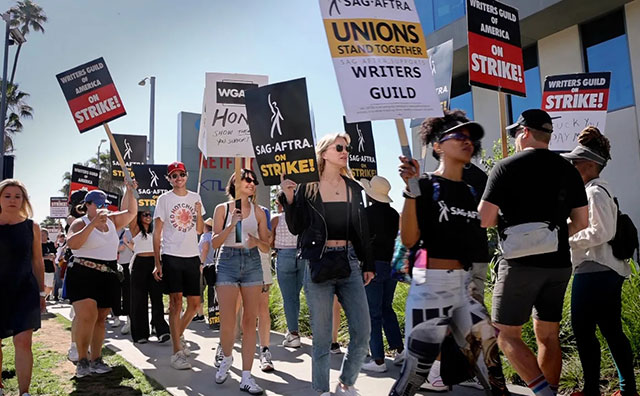
Actors officially join screen writers on strike picket lines, Los Angeles, July 14. One out, all out, and stay out together until all Hollywood unions win big! (Photo: USA Today)
An abbreviated version of these articles was issued as an Internationalist Group leaflet.
AUGUST 29 – It was more than 100 days into the strike by 10,000 Hollywood screenwriters that the employers in the Alliance of Motion Picture and Television Producers (AMPTP) made a new offer to the Writers Guild of America (WGA), which walked out on May 2. It’s been over six weeks now since the 160,000 actors of SAG-AFTRA (Screen Actors Guild-American Federation of Television and Radio Artists) officially joined the writers on the picket lines, and the AMPTP has yet to respond to the union’s demands. Production at the major studios is basically shut down. But as the Hollywood cartel seeks to drag out the battle, bold action by the unions is needed to break the stalemate.
The studios are hard-lining it, seeking to starve out the writers and actors, and eventually to pick off one union at a time. That is a standard employer tactic, facilitated by the division of the workforce into many craft unions. But it comes at a time when technological change – the dominance of streaming, introduction of artificial intelligence (AI) – poses an existential threat to entertainment workers. And while Wall Street financiers are pushing to milk short-term profits from a notoriously fickle and unpredictable industry, tens of thousands of “below-the-line” movie crew workers in IATSE (stage hands), Teamsters, musicians and others whose labor is crucial to any production, are out of work. This is a crucial battle, and to win it, the dual strike should become one strike by all the entertainment industry unions together.
SAG-AFTRA finally declared a walkout on July 14 after negotiations collapsed as the movie industry bosses refused to engage on actors’ key demands, on residuals (payments for reruns of shows) for streaming and limits on AI. The AMPTP’s response to the union’s already pared-down wage demands (11% in the first year) was an insulting “offer” (5%), which after last year’s record inflation would amount to a wage cut. As thousands of actors joined with their WGA colleagues, there were large and energetic picket lines outside major film and TV studios, including Netflix, Amazon and Universal Studios. These have continued, week after week, and this show of determination and unity has not been lost on the media moguls.
But that alone is not enough to make them back down. The studios were gearing up for months for a strike, stockpiling scripts and shows. After the WGA had been out for over two months, a studio executive told Deadline (11 July), “The endgame is to allow things to drag on until union members start losing their apartments and losing their houses.” The “plan to grind down the [writers’] guild has long been in the works,” the paper reported, quoting an industry insider saying “they’re going to let it bleed out.” Even if this was just scare talk, trying to intimidate strikers into submission, it hasn’t worked. Three days later, SAG-AFTRA went out. It is the first time actors staged a major walkout since 1980, over four decades ago, and the first time both unions struck simultaneously since 1960.
The New York Times (14 July) wrote, “the actors’ uncharacteristic resolve caught senior executives and producers off guard.” The SAG-AFTRA leadership had given plenty of indications it was ready to compromise, from the disclaimer on the bottom of its “solidarity” picket signs saying it wasn’t asking anyone not to cross1 to a video message to the members saying that talks had been “extremely productive” and suggesting a settlement was at hand. Alarmed actors put together a letter to the union tops saying “we are prepared to strike” and “we are concerned by the idea that SAG-AFTRA members may be ready to make sacrifices that leadership is not” (Variety, 27 June). Over 1,000 actors signed the letter, including Oscar winners Meryl Streep, Jennifer Lawrence and Rami Malek.
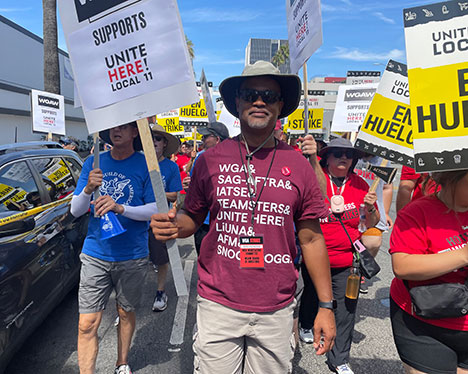 WGA and SAG-AFTRA join
with hotel workers of UNITE-HERE in march of striking
unions, Los Angeles, July 21. If all Hollywood unions
struck together they could win, hands down. For a
single union of all media workers! (Photo: Megan Jamerson/KCRW)
WGA and SAG-AFTRA join
with hotel workers of UNITE-HERE in march of striking
unions, Los Angeles, July 21. If all Hollywood unions
struck together they could win, hands down. For a
single union of all media workers! (Photo: Megan Jamerson/KCRW)Its spine stiffened, the actors union leadership went back to its 48-page list of proposals, whose key demands the studio bosses either rejected outright (revenue-sharing on streaming) or didn’t address (AI). But even as the studios haven’t budged, inside of a couple of weeks SAG-AFTRA began making “interim agreements” with smaller studios and independent productions (currently 286 and counting) granting permission for actors to work on them. This provoked a lot of heat, including from comedian Sarah Silverman who called this by its right name: “It’s scabbing,” at a time when “writers, actors, crew people” are “sacrificing their livelihood for this cause.” After the WGA raised a stink, the SAG-AFTRA tops said no future interim agreements would be made for projects being struck by the writers – but nothing about rescinding the already granted permissions.
On top of which, the whole pretense that these are productions independent of the top studios is a hoax. The list of “indie” productions going forward in the middle of a strike include such big-budget movies like the sci-fi horror show The Watchers, which will go to Warner Brothers for theatrical release; and 15 series including the Israeli spy thriller Tehran, whose first season featured a Mossad agent tasked with preparing an Israeli air force strike on a nuclear plant. This piece of blatant war propaganda is being shot in Greece and will be broadcast, like the previous two seasons, on Apple TV+. Various other “interims” will also be broadcast and distributed by AMPTP majors, who in this way can keep production rolling, strike or no strike.
The interims undercut the impact of the strikes, which should shut down all film production solid! Although the AMPTP restarted talks with the Writers Guild – perhaps figuring it is the weaker of the two unions – to give the appearance that bargaining is going on, it hasn’t agreed to key demands. The WGA now says it wants the right to honor other unions’ picket lines as provided for in Teamsters contracts. Yes, the WGA – and SAG-AFTRA – should demand contract language affirming members’ right to refuse to cross a picket line. They should also get rid of no-strike clauses. It will take an all-out strike to win such demands. But for one of the unions to go back before the other would be a huge betrayal. Enforcing the labor principle that picket lines mean don’t cross requires collective action.
When studio bosses summoned WGA negotiators to talk on August 22, it was not to respond to the union’s counterproposal, given to them a week earlier, but instead to announce that they were going to bypass the union leadership and try to stampede the members into accepting the AMPTP offer. It was, the WGA said in a statement, “a meeting to get us to cave.” The companies’ strategy is “to bet that we will turn on each other.” Yes, and it is the responsibility of the union leaderships to see that doesn’t happen.
As the networks gear up for the fall season with plans to draw on backlogs of completed series, plus a slew of unscripted “reality TV” shows, the unions, rather than hinting at settling on their own, should escalate the strike to include television, radio and digital media, programs covered by the Network TV Code, and then on to broadcast news. That would violate no-strike contract provisions? You bet – shred them with militant union action! Above all, with two unions fighting the same bosses over many of the same demands, it is critical that the actors and writers stay out together until both unions’ demands are won. That means a fight against the WGA and SAG-AFTRA union bureaucrats who are preparing to hang separately. Militant strikers should insist: No one goes back until everyone goes back!
And that would point the way to a single media workers union covering the entire industry. More on that below.
Wall Street Puts the Screws to Hollywood
In her press conference announcing the strike, Fran Drescher gave what was widely deemed a fiery performance. To many labor activists it sounded more like the star of the TV series The Nanny was reading a script for her latest role, as militant union leader: “The jig is up, A.M.P.T.P. We stand tall. You have to wake up and smell the coffee. We are labor and we stand tall…. We are being victimized by a very greedy entity. I am shocked by the way the people that we have been in business with are treating us.”
Any class-conscious trade-unionist knows that capitalism without greed is impossible. And the idea that the workers in the industry are “in business” with the bosses speaks volumes about the SAG-AFTRA leader’s consciousness, though not unexpected for someone whose latest gig was as a “brand ambassador” for the luxury fashion house Dolce & Gabbana. But, to be fair, when Drescher denounced “employers [who] make Wall Street and greed their priority,” she was pointing to something real. And it’s not just that “they plead poverty … when giving hundreds of millions of dollars to their CEOs.”
There has been a significant change in the entertainment industry of late as the traditional studios are dwarfed by, or have been swallowed by, media monsters like Apple (market capitalization, $2.8 trillion, owner of Apple Studios), the e-commerce giant Amazon (market cap $1.4 trillion, owner of Amazon Studios/Amazon Prime Video and MGM), conglomerates like Walt Disney Company ($238 billion) and Comcast ($214 billion, owner of NBCUniversal), streaming king Netflix ($184 billion), etc. These mega corporations are not focused on filmmaking; they produce and distribute “content” – often having a “chief content officer” – and making movies is only a small part of their businesses. In fact, some writer-producers report that they have been told their work isn’t “second screen enough” – i.e., that it is too compelling, and would distract from viewers scrolling on their phones. So in the quest for “content,” the bosses are demanding the visual equivalent of Muzak, or elevator music!
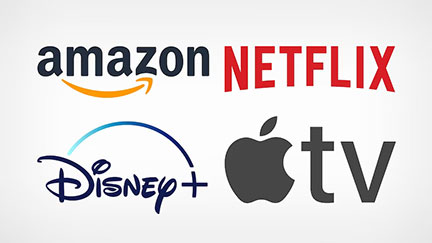 Know your enemy. A dozen
entertainment industry unions (and a half-dozen IATSE
locals) bargaining separately with a cartel of some of
the richest corporations in the U.S. (right, with a
market capitalization of almost 5 trillion
dollars) is a ticket for defeat. For a single
union of all media workers! (Photo: Megan Jamerson/KCRW)
Know your enemy. A dozen
entertainment industry unions (and a half-dozen IATSE
locals) bargaining separately with a cartel of some of
the richest corporations in the U.S. (right, with a
market capitalization of almost 5 trillion
dollars) is a ticket for defeat. For a single
union of all media workers! (Photo: Megan Jamerson/KCRW)Moreover, during the pandemic, when streaming services like Netflix and Amazon Prime exploded as millions watched while stuck at home, many studios borrowed heavily from Wall Street to launch a wave of mergers and quickly expand production, at a time when interest rates were rock bottom. In the center of international banking, the particular sector that latched onto media production was private equity capital, the far-less-regulated financial and investment houses known for ruthlessly shuttering properties deemed insufficiently profitable. In the middle of the current strikes, Insider (26 July) reported “17 private-equity players making big bets on Hollywood, even as economic uncertainty and strikes roil the entertainment business.”
The players and some of their assets in this freewheeling market include major investment firms such as BlackRock ($8.6 trillion in assets under management; funding Macro TV/film studio); Blackstone ($991 billion; investments in Candle Media, Westbrook, Hello Sunshine and ATTN:; Apollo ($600 billion; backing HarbourView, Legendary Entertainment and North Road Company); KKR ($510 billion; Skydance, Plan B, UFC, WME talent agency); Carlyle ($381 billion; Content Partners), and a whole bunch of smaller multibillion-dollar funds. These are cutthroat capitalists, and some are pushing AI big time. Like the venture capitalists of Kyber-Knight Capital, which says that generative AI (creating new text and images by mining all accessible existing material) “will let filmmakers work faster and cheaper” (Variety, 16 August).
That is the point, isn’t it? Return on capital. Not that Hollywood hasn’t always been focused on the bottom line, but these behemoths are only interested in short-term profits. Early in 2023, the Wall Street analysis firm MoffettNathanson issued a research note concluding that “streaming is, in fact, not a good business.” It went on: “Cash flows are sorry ghosts of their former selves. Balance sheets are loaded with debt in a higher interest rate environment.” It concluded: media companies must introduce “a new age of rationalization” with “a focus on driving profitable growth” (Hollywood Reporter, 19 January). A Morgan Stanley analyst declared that the industry was embarking on a new phase of “cost rationalization” and consolidation, with some firms exiting “direct-to-consumer content delivery.”
It’s no secret that the media moguls haven’t yet figured out a way to make oodles of profits out of streaming. Consulting company Deloitte’s “2023 Media & Entertainment Industry Outlook” calculated that “streaming generates one-sixth as much revenue per home as pay TV.” When Disney announced it had lost half a billion dollars in its streaming operation in April-June 2023, this was judged “encouraging” by analysts, as it was only one-third of its losses in 4th quarter 2022. In this fight, WGA and SAG-AFTRA are going up against both Hollywood and Wall Street. That is precisely why, as studios try to drastically cut production costs, the striking unions have to hang tough in demanding a huge increase in pay. Otherwise, writers’ and actors’ livelihoods will end up on the cutting room floor.
The response of the unions has been vaguely “anti-corporate” rhetoric from SAG-AFTRA, and from WGA, appeals for more government oversight and regulation of the top streaming companies (Disney, Amazon and Netflix).2 But asking for more stringent anti-trust enforcement won’t produce more competition in the media industry, any more than the 1911 Sherman Anti-Trust Law did. At that time, the Standard Oil monopoly became the Seven Sisters oligopoly, and oil prices were controlled by a cartel instead of a single producer. “Anti-monopoly” laws never work, or at most only for a brief period, as concentration and centralization of capital are inherent in the capitalist system.3 Only sharp class struggle for socialist revolution can defeat the monopoly power of the media giants. ■
As Studios Hard-Line It, Unite the Strikes!
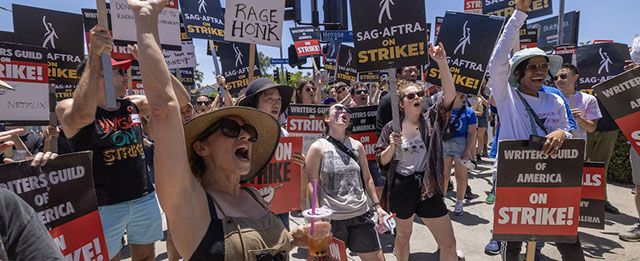
SAG-AFTRA and WGA pickets outside Paramount Studios in Los Angeles, July 14. Unite the strikes to win!
(Photo: David McNew/Getty Images)
A Hollywood strike is different in many ways from a Teamster trucker, auto worker or hotel worker strike. In this petty-bourgeois sector, you have A-list stars walking a picket line (or not), bizarre pay formulas and vast differences in income between those with a steady gig or role in an ongoing continuing series, for example, and background actors whose pay amounts to minimum wage, if that. There are also the thousands of workers – stage hands, camera crews and other categories in the TV and film industry toiling behind the scenes to bring the production to life. They live paycheck to paycheck and are now out of work. Plus there’s a whole lot of nepotism and not a lot of diversity at any level. But at bottom, this strike is a showdown between capital and labor.
A key issue for the Writers Guild is minimum staffing levels. The union had proposed a minimum of six writers for ten weeks in writers rooms for TV series as they develop episodes prior to receiving a go-ahead (“pre-greenlight”). The AMPTP’s counteroffer agreed to the ten weeks, but no staffing minimum. The WGA had demanded that AI not be used by the studios to write/rewrite literary material or as source material. In their August 11 offer, the bosses trumpeted “landmark protections” on “generative artificial intelligence” (GAI) material. Which are? Written material generated by AI “will not be considered literary material,” and writers would be paid and credited as before for the material they produce. So the studios would use GAI scripts however they want, just not call them “literary”! It’s even possible that the AMPTP language would enable studios to copyright GAI scripts, which under present court rulings they can’t do.
The WGA proposed to establish weekly pay during pre-greenlight and post-greenlight writers rooms, a big issue for writers being paid the minimum, who depend on this income to cover rent, food and other necessities. The AMPTP has refused outright to even discuss this. For both the WGA and SAG-AFTRA, a key demand was to establish residuals based on viewership of streaming videos. Until now, the studios have refused to release any information at all about viewership. In their counteroffer, the bosses now say they will let a handful WGA staffers view limited streaming viewer data (which the studios produce) for three years, and only then would they discuss residuals! So for now, the studios would continue to pay next to nothing to writers on streaming videos and series. The unions should demand that the studios and streaming platforms open their books to workers inspection, on viewership, subscriber/advertising income and other financials.
The grotesque injustice of the present Hollywood pay system has been highlighted by the hit series Orange Is the New Black, which aired for seven seasons, from 2013 to 2019. It was the longest-running, most-watched original series on Netflix, whose “runaway success” built the brand and the streaming model that now dominates the industry. Yet while some actors eventually received $200,000 per episode, many earned a pittance. One cast member, Beth Dover, reports that she lost money in her first two seasons, because she was cast as a “local hire,” and therefore was responsible for her own airfare and lodging. Residual payments were no better. Actress Kimiko Glenn (who appeared in seasons 2 through 5 as a recurring character, and as a one-episode guest star in season 7) posted a video of herself in 2020 looking over a statement of foreign streaming residuals for over twenty episodes, adding up to a grand total of $27.30 (“‘Orange Is the New Black’ Signalled the Rot Inside the Streaming Economy,” New Yorker, 12 July).
In face of that reality, the weak-kneed response by the WGA to the AMPTP “offer” that offers zilch or close to it on key issues of staffing, weekly pay and streaming residuals was that the “counteroffer is neither nothing, nor nearly enough” (WGA on Strike, 24 August). Meanwhile, the union tops tallied up the cost of their proposal for each studio, ranging from 2/10ths of 1% of annual revenues for Netflix to less than 1/100th of 1% for Amazon and Apple. This, and illusory talk of “real discussions” and “movement” by the studios on AI protections, suggests that WGA leaders are just looking to hold on to the present system, in which writers make chicken feed, and would be ready to settle for very little indeed. The SAG-AFTRA tops, meanwhile, are begging the AMPTP to talk with them.
SAG-AFTRA president Drescher got rave reviews for her
July 13 press conference in part because it was what the
ranks and a lot of people wanted to hear, especially
against the smug disdain of Disney studio chief Bob Iger
(annual salary $27 million), who dissed strikers’
demands as “unrealistic.” Yet, as the press noted, the
actors union leader’s own remark, that “everybody else
tinkers around our artistry,” was a put-down that
“firmly distinguished the actors’ cause and claim from
the ongoing WGA strike”4 – and from all
others who make the show go on. The fact is, Drescher
(net worth $25 million) and SAG-AFTRA national executive
director Duncan Crabtree-Ireland (annual salary
$1,014,939 last year!) inhabit a different world than
the working and auditioning actors who are the large
majority of the union’s membership.
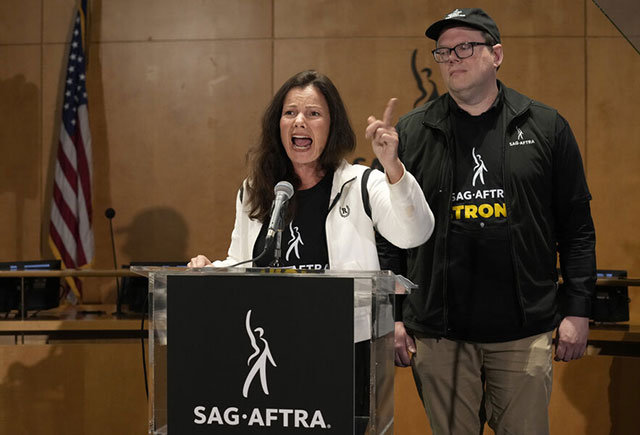
SAG-AFTRA president Fran Drescher and national executive director Duncan Crabtree-Ireland announce actors strike at July 13 press conference. (Photo: Chris Pizzello / AP)
That is not just true of the actors union leaders personally but of the labor bureaucracy overall, which is a privileged petty-bourgeois social layer that seeks to mediate between labor and capital. They do this mainly by clamping down on union militancy, although they are sometimes forced to go through the motions in order to preserve their position atop a workers organization. At an appearance at the New York City Council, Drescher made the point that 86% of SAG members do not even make the $26,470 annually from screen acting required to qualify for the union’s health insurance. And now a number of strikers are reporting that they are on the verge of losing their health care coverage.
It is high time for the ranks to take charge and unite the strikes. One reason the WGA leadership reacted sharply to the AMPTP publicizing its “offer” was that the union tops haven’t even told their members or the public what their counteroffer was. They want to bargain behind closed doors, in order to hide their concessions to the bosses. Strikers should demand to know the unions’ current demands, and should insist on elected mass strike committees of several hundred delegates, recallable at any time, to organize the struggle and decide on demands. Such committees could meet together (along with reps from IATSE and Teamsters) to give a united response to the AMPTP’s divide-and-conquer tactics, and declare that the strikes will go on until both unions have settled.
This should be a prelude to a struggle to build a single trade union of all media workers. The guild mentality of each profession jealously guarding its bailiwick (and restricting its membership) is an obstacle to defeating the trillion-dollar e-commerce giants and media conglomerates worth hundreds of billions. In 2021, IATSE voted overwhelmingly to strike – and would have if it weren’t for a sellout union leadership – over miserable pay and killer job shifts, demanding the right to a good night’s sleep and a weekend5 IATSE members, as well as Teamsters, animators, make-up artists and other guilds also depend on residuals to fund motion picture industry health plans, so bring them into this strike now, to lay the basis for common action (including simultaneous expiration of contracts) in the future.
In the meantime, class struggle militants can act together to set up joint union safety committees at every studio and on every shoot to avoid tragedies like on the set at Rust, where IATSE Local 600 director of photography Halyna Hutchins was killed shortly after camera operators walked off the set complaining of dangerous conditions (and just after scabs had arrived to replace them).
Break with the Democrats, Oust the Bureaucrats – Build a Class Struggle Workers Party!
Leaders of both striking unions have said workers in the industry are facing “existential threats.” They got that right, and those threats are coming not only from the studios but from the top levels of international finance capital. To win a brawl against powerful forces who are trying to drag things out in order to starve strikers out, chanting “one day longer, one day stronger” won’t cut it. It’s necessary to sharply increase the intensity of the struggle, extending the strike to close down broadcasts and enlist the power of the labor movement as a whole in a broad-scale class-struggle against the movie moguls and titans of commerce, finance and industry. And that means, like any class struggle, it must be fought politically, against all the parties and politicians of capital.
When the WGA balked at the studios’ proposal, what was the AMPTP’s response? It hired a new crisis response public relations firm, The Levinson Group, one of whose senior advisors is Matt McKenna, former spokesperson for Democratic president Bill Clinton, for the Clinton Foundation and Hillary Clinton’s 2016 presidential bid. And the WGA? It hired Precision Strategies, led by Stephanie Cutter, who was deputy campaign director for Democratic president Barack Obama’s 2012 campaign (Hollywood Reporter, 25 August). As for SAG-AFTRA, Fran Drescher is a strong supporter of Hillary Clinton and even eyed her vacated Senate seat in 2008. While Drescher has proclaimed herself “anti-capitalist,” this whole fight is being waged within the confines of the capitalist Democratic Party.
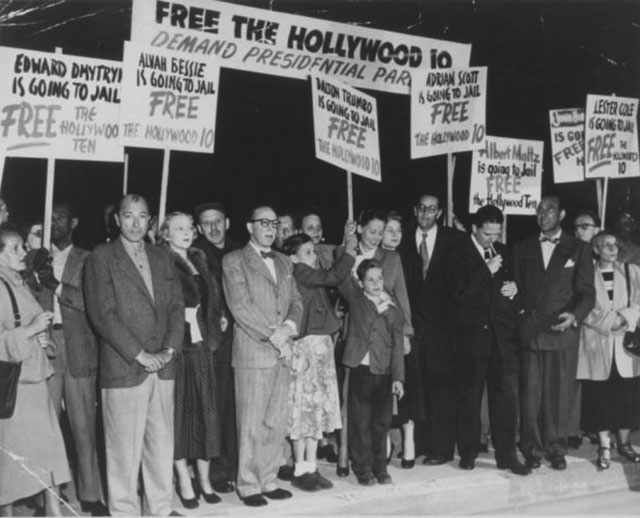
(Above) Rally for Hollywood 10 screenwriters and actors in Los Angeles as they are being sent to jail, June 1950. (Below) Democrat Ronald Reagan, then head of SAG, testifying before Democrat-led House Un-American Activities Committee that witch-hunted leftists in Hollywood. (Photos: Zinn Education Project; Ronald Reagan Presidential Foundation)
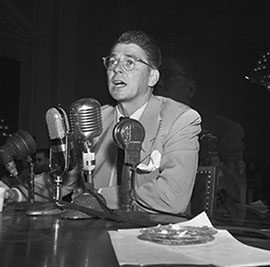
Hollywood studio bosses are kingmakers in the Democratic Party, Hollywood stars are prominent campaigners for Democrats. The last time screenwriters and actors were on strike at the same time, in 1960, when Ronald Reagan (who went on to become one of the most notorious union-busters in history) headed SAG, he was a Democrat. (After getting residuals and health care on the strength of the dual strike, Reagan left the writers hanging out to dry.) And the anti-communist witch-hunting of the Hollywood Ten actors, writers, directors was spearheaded by the House Un-American Activities Committee (HUAC), led by Democrats, while Reagan named names and the blacklisting was carried out by the studio bosses, also Democrats. This was all long before Republican senator Joseph McCarthy’s name became synonymous with “red” purges in the anti-Soviet Cold War.
Today, Hollywood strikers are tremendously popular, as working people are ground down by rampant profiteering driving up gas prices and food prices and driving down living standards. But that popularity needs to be mobilized. To successfully wage an all-out battle against capital, we need to oust the union bureaucrats, who see themselves as “in business” with the bosses, a bourgeois concept that is sold to even the most hard-pressed actors; to break with the Democrats, who pass strikebreaking legislation against rail workers while waging an ever-escalating proxy war in Ukraine that is careening toward World War III against Russia and China; and to build a class-struggle workers party, to lead all the oppressed in the fight for a workers government.
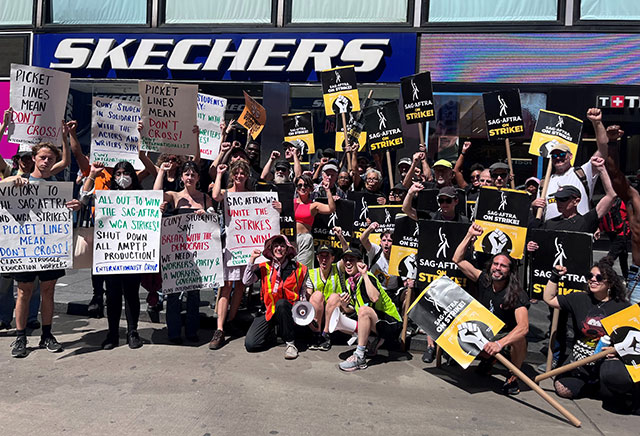
Internationalists at SAG-AFTRA picket line in NYC, August 18. Break with the Democrats, build a workers party! (Internationalist photo)
Motion picture making is a cruel industry. As generations of talented young people follow their dreams to the dream factory, they audition for bit parts and eke out a precarious existence waiting on tables, or other gig work, trying to make ends meet while endlessly hoping to be “discovered” and have their shot at the big time. Hollywood has always been a dictatorship, as the studio system monopolized production and used the star system to promote and control the headliners. It is where sexual exploitation was not an aberration but an industry standard, as the road to stardom (or just a steady gig) was often via the director’s couch. To break out of that mold, to build a system of cultural creation through collaborative effort, making possible artistic works of all kinds far superior in every way to a lot of the garbage being churned out today, will require nothing less than a revolution.
Today we are in the middle of a strike that may go on and on as the bosses threaten to starve out writers, actors and all who join them in solidarity. In our May 15 Internationalist leaflet, we emphasized “the urgent need for united action across the industry to shut down all the production companies in the AMPTP.” This is all the more true today, as we say: One Out, All Out, and Stay Out Together Until All Hollywood Unions Win Big! ■
- 1. See our May 15 leaflet, “To Win the Strike, All Out to Shut Down Hollywood!” in The Internationalist No. 69-70, January-May 2023.
- 2. Writers Guild of America West, The New Gatekeepers: How Disney, Amazon, and Netflix Will Take Over Media (August 2023). Earlier, the WGA West issued another report, Broken Promises: Media Mega-Mergers and the Case for Anti-Trust Reform (December 2021) on the biggest media mergers of the previous decade.
- 3. Karl Marx, Capital, Vol. 1, Chapter 25: The General Law of Capitalist Accumulation.
- 4. “Fran Drescher Delivered the Performance of a Lifetime as SAG-AFTRA President,” Variety, 13 July.
- 5. See “IATSE Members Voted to Strike: Let’s Do It,” The Internationalist, October 2021.